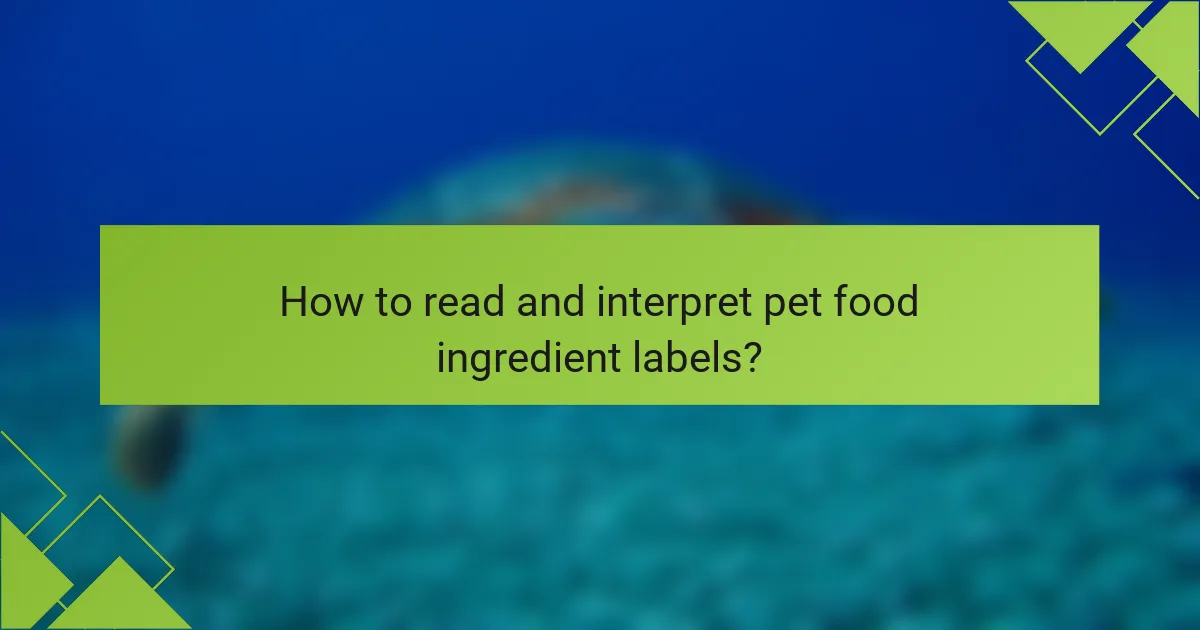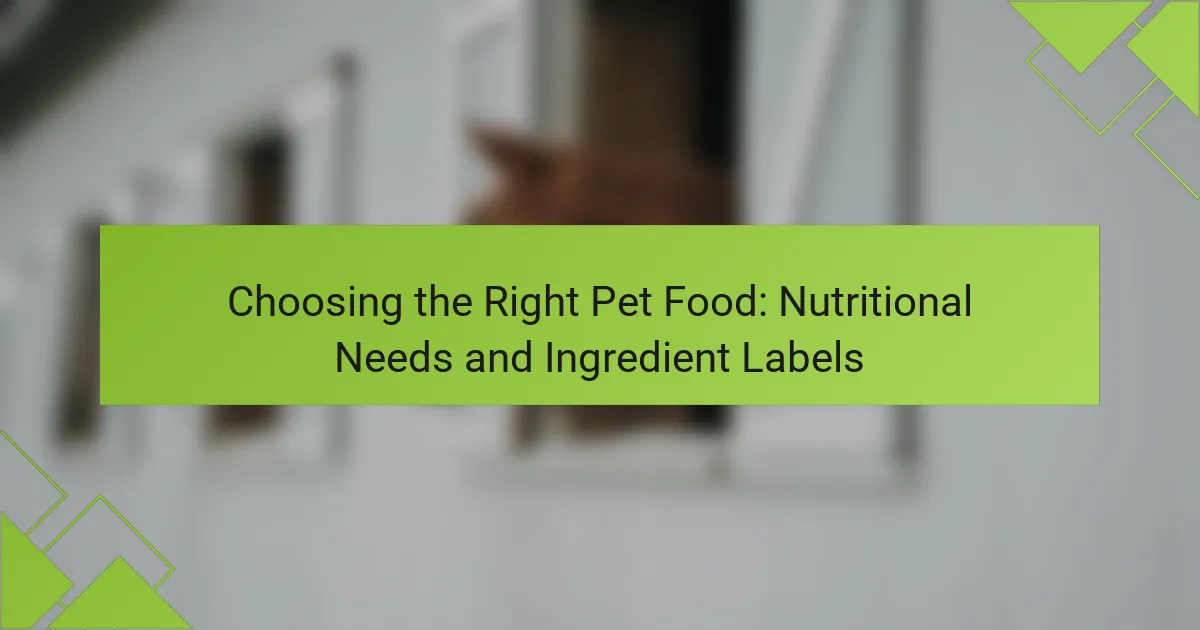Choosing the right pet food is essential for your pet’s health and well-being. Nutritional needs must be met through balanced ingredients like proteins, fats, and carbohydrates. Understanding ingredient labels helps identify quality sources and avoid fillers. Assess your pet’s specific dietary requirements and consult with a veterinarian for tailored recommendations.

What nutritional needs should pet food meet?
Pet food must meet essential nutritional needs like proteins, fats, carbohydrates, vitamins, and minerals. These components support growth, energy, and overall health in pets. High-quality protein sources, such as meat or fish, are crucial for muscle development. Healthy fats provide energy and support skin and coat condition. Carbohydrates offer a source of energy and help with digestion. Vitamins and minerals ensure proper bodily functions and immune support. Choosing pet food with a balanced formulation is vital for a pet’s long-term well-being.
How do different life stages affect pet nutritional requirements?
Different life stages significantly influence pet nutritional requirements. Puppies and kittens need higher protein and fat for growth, while adult pets require balanced nutrients for maintenance. Senior pets often need lower calories and specific nutrients to support joint health and digestion. Adjusting food based on life stage ensures optimal health, energy, and longevity.
What role do specific dietary needs play for pets with health issues?
Specific dietary needs are crucial for pets with health issues, as tailored nutrition can significantly improve their well-being. Pets with conditions like allergies, diabetes, or kidney disease require specialized diets to manage symptoms and promote recovery. For instance, low-protein diets benefit pets with kidney issues by reducing strain on their kidneys. Additionally, high-fiber foods may assist pets with diabetes by regulating blood sugar levels. Understanding ingredient labels helps pet owners choose appropriate foods that meet these specific nutritional requirements. Regular consultation with a veterinarian ensures that dietary choices align with the pet’s health status.

How to read and interpret pet food ingredient labels?
Reading and interpreting pet food ingredient labels is crucial for selecting a nutritious diet. Focus on the first five ingredients, which are the most significant in terms of quantity. Look for high-quality protein sources, such as meat or meat meals, listed at the top. Avoid vague terms like “meat by-products” which can indicate lower quality.
Consider the presence of whole grains or vegetables, which provide essential nutrients and fiber. Check for added vitamins and minerals, indicating a balanced formulation. Be cautious of artificial preservatives and fillers, as they do not contribute to your pet’s health.
Understanding these elements helps ensure your pet receives the appropriate nutrition tailored to their specific needs.
What are the key components of a pet food label?
Key components of a pet food label include the ingredient list, guaranteed analysis, nutritional adequacy statement, feeding guidelines, and manufacturer information. These elements help pet owners assess the quality and suitability of the food for their pets’ dietary needs. The ingredient list details the specific components, while the guaranteed analysis provides nutrient percentages. The nutritional adequacy statement confirms the food meets established standards. Feeding guidelines offer recommendations for portion sizes, and manufacturer information ensures accountability and traceability.
How do ingredient sourcing and quality affect pet food?
Ingredient sourcing and quality significantly impact pet food’s nutritional value and safety. High-quality ingredients ensure better digestibility and nutrient absorption. Sourcing from reputable suppliers reduces the risk of contaminants, enhancing overall pet health. For example, fresh, whole food ingredients provide essential vitamins and minerals, while artificial additives may lead to health issues. Prioritising quality ingredients fosters long-term well-being in pets.

Which ingredients are essential for a balanced pet diet?
Essential ingredients for a balanced pet diet include proteins, fats, carbohydrates, vitamins, and minerals. Proteins provide essential amino acids for growth and repair. Fats supply energy and support cell function. Carbohydrates offer energy and aid digestion. Vitamins and minerals are crucial for various bodily functions. Prioritising high-quality ingredients ensures optimal nutrition for pets.
What are the benefits of whole food ingredients versus by-products?
Whole food ingredients provide superior nutrition compared to by-products. They contain essential nutrients in their natural forms, promoting better health for pets. Whole foods, such as meat, vegetables, and grains, offer higher digestibility and bioavailability of nutrients. By-products often lack the same nutritional value and can include lower-quality ingredients. Choosing whole food ingredients can lead to improved energy levels, healthier skin, and a shinier coat for pets.
How do protein sources vary in pet food?
Protein sources in pet food vary widely, impacting nutritional value and digestibility. Common sources include meat, fish, eggs, and plant-based proteins. Animal proteins generally offer complete amino acid profiles, while plant proteins may lack certain essential amino acids. Quality and sourcing of these proteins also influence their digestibility and palatability for pets.

What are the common misconceptions about pet food ingredients?
Common misconceptions about pet food ingredients include the belief that all natural ingredients are inherently better, that grain-free diets are always healthier, and that by-products are low-quality. Many pet owners assume that a higher price guarantees superior quality, while some think that food labeled as “human-grade” is always safe for pets. Additionally, some believe that meat should be the first ingredient, disregarding the importance of a balanced diet. Understanding these misconceptions helps in making informed choices for a pet’s nutritional needs.
Why are grain-free diets controversial for pets?
Grain-free diets for pets are controversial due to potential health risks and nutritional imbalances. Critics argue that these diets may lead to heart issues, particularly dilated cardiomyopathy, linked to certain grain-free formulations. Additionally, some pets may require grains for balanced nutrition, making these diets unsuitable for them. The debate continues as more research emerges on the long-term effects of grain-free feeding.
What myths exist about artificial additives in pet food?
Many myths about artificial additives in pet food suggest they are harmful, but many are safe and serve specific purposes. For instance, preservatives can enhance shelf life and prevent spoilage. Some owners believe natural ingredients are always better, yet artificial additives can be beneficial for nutrition and palatability. Misunderstandings often arise from a lack of knowledge about the roles these additives play in pet health. Ultimately, informed choices rely on understanding ingredient labels and the nutritional needs of pets.

How can pet owners choose the best food for their pets?
Pet owners can choose the best food by evaluating nutritional needs and ingredient labels. Focus on high-quality protein sources, essential vitamins, and minerals tailored to your pet’s age, size, and health conditions.
1. Assess your pet’s specific dietary requirements based on their breed, age, and activity level.
2. Read ingredient labels, prioritising whole foods and avoiding fillers or artificial additives.
3. Consult with a veterinarian for personalised recommendations and to address any health concerns.
4. Monitor your pet’s response to the food, adjusting as necessary for optimal health and well-being.
What factors should be considered when selecting pet food brands?
When selecting pet food brands, consider nutritional content, ingredient quality, brand reputation, and specific dietary needs of your pet. Nutritional needs vary by species, age, and health conditions. Ingredient labels should list high-quality proteins and avoid fillers. Research brand reputation through reviews and certifications to ensure safety and quality. Additionally, consult with a veterinarian to address any unique dietary requirements your pet may have.
How can pet food comparisons help in making informed choices?
Pet food comparisons provide essential insights for making informed choices. Evaluating nutritional needs and ingredient labels helps identify suitable options for specific pets.
Comparing different brands reveals variations in protein sources, carbohydrate content, and essential vitamins. For instance, some brands emphasise whole meats, while others may include fillers. Understanding these differences ensures pets receive balanced nutrition tailored to their health requirements.
Additionally, ingredient labels often highlight unique attributes, such as grain-free or hypoallergenic options. These distinctions cater to pets with specific dietary needs, enhancing overall well-being.
In summary, thorough comparisons of pet food empower owners to select products that align with their pets’ health goals, ensuring optimal nutrition and care.
What are the signs of a good quality pet food?
Good quality pet food has identifiable, high-quality ingredients, a clear nutritional profile, and meets specific dietary needs. Look for meat as the first ingredient, absence of fillers, and appropriate nutrient balance.
Signs of quality include:
– Clear labeling of ingredients
– Presence of whole foods
– Specific nutrient content, such as protein percentage
– Absence of artificial additives or preservatives
– Compliance with AAFCO standards
Choosing pet food that aligns with these signs ensures optimal health for your pet.
What common mistakes do pet owners make when choosing pet food?
Pet owners often make mistakes like focusing solely on price, ignoring ingredient quality, or not considering their pet’s specific dietary needs. Many choose brands based on marketing rather than nutritional content. Additionally, some fail to transition foods gradually, which can upset their pet’s digestion. Understanding pet food labels and the unique nutritional requirements of different animals is crucial for making informed choices.
How can pet owners optimize their pet’s diet for health and longevity?
To optimize a pet’s diet for health and longevity, focus on high-quality pet food that meets their specific nutritional needs. Look for ingredient labels that prioritise whole foods and avoid fillers.
Choose pet food with a high protein content, ideally from named animal sources. Essential fatty acids, vitamins, and minerals are crucial for overall health. Consider the life stage of your pet, as dietary requirements vary between puppies, adults, and seniors.
Regularly consult with a veterinarian to tailor the diet to your pet’s unique health needs. Monitor weight and overall health to adjust portions and ingredients as necessary. This proactive approach can significantly enhance your pet’s quality of life and longevity.
